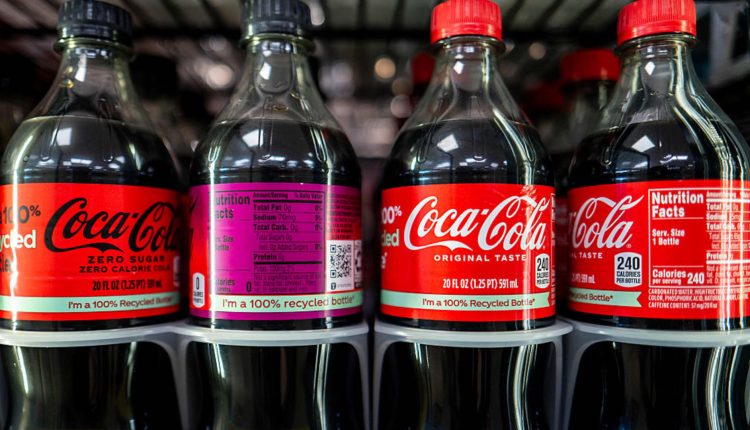Cola drinks are displayed at a 7-Eleven store in Austin, Texas on July 17, 2025.
Brandon Bell | Getty Images
Due to recession fears, a government shutdown and tariff uncertainty, consumers are increasingly diverging in their spending.
Wealthier Americans are leveraging their purchasing power while lower-income Americans begin to withdraw – commonly referred to as a “K-shaped” economy. Friday’s consumer price index report shed more light on the pressures facing much of the country.
The CPI report, which measures price changes for a range of goods and services, was delayed due to the government shutdown and was originally scheduled to be released nine days earlier. The report was cooler than expected, showing a 0.3% increase from the previous month. That puts the annual inflation rate at 3% and signals a likely rate cut by the Federal Reserve next week.
Part of the CPI report also helps determine the Social Security Administration’s cost of living adjustment, which the agency said Friday will be 2.8% in 2026.
Low- and middle-income consumers are hit hardest by the rising costs of essential goods like food and gasoline. Meanwhile, wealthier investors benefited from stock market recoveries and rising property values. Current data from JPMorgan’s The cost of living survey found that income bracket was a major factor in Americans’ differing views on the current economic situation.
This is where the division begins to take hold:
Food and Drink
Coca Cola, Often viewed as an indicator of consumer financial health, the company has recognized the divergence across its business.
More expensive products that are more accessible to high-income consumers, such as Topo Chico sparkling water and Fairlife protein shakes, are boosting the company’s sales growth, CEO James Quincey told CNBC’s “Squawk on the Street” on Tuesday.
At the same time, Coca-Cola is seeing higher demand both at dollar stores, which target low-income consumers looking for bargains, and at upscale stores, which tend to target wealthier consumers, such as fast-casual restaurants and amusement parks.
McDonald’s CEO Chris Kempczinski told CNBC’s “Squawk Box” in early September that the burger chain’s expansion of value for money was a response to a divided consumer landscape, or a “two-tier economy,” as he called it.
While Kempczinski said the company is seeing good performance among higher-income consumers, it’s “a different story” when it comes to lower- and middle-income guests.
“Traffic for lower-income consumers is down double digits, and that’s because people are either skipping a meal … or just eating at home,” he said last month.
A similar dynamic is playing out Chipotlesaid CFO Adam Rymer.
“There are certain groups of consumers, definitely on the lower income side, that are under pressure right now. We need to take that into account when we look at prices going forward,” Rymer told Reuters in July.
On Friday, Procter & Gamble said the company is seeing K-shaped shopping behavior among its consumers, with wealthier shoppers buying larger pack sizes at club retailers and lower-income shoppers using up their inventory before returning to stores.
“The consumer environment is not great, but it is stable,” Chief Financial Officer Andre Schulten said in a call with reporters.
Cars and airfares
According to Cox Automotive’s Kelley Blue Book, last month the average price of a new vehicle topped $50,000 for the first time ever.
The record prices come as auto loan defaults and repossessions increase, particularly among borrowers with FICO scores below 620.
“Today’s automotive market is driven by wealthier households that have access to capital and good borrowing rates, supporting the high end of the market,” Erin Keating, principal analyst at Cox Automotive, said in a statement last week.
And although airlines have been testing premium offerings for years, the more expensive tickets have been gaining momentum in recent months.
Delta Air Lines said earlier this month that revenue from its premium offerings is expected to surpass that of bus cabins next year, with CEO Ed Bastian saying he sees no signs of slowing in the roomier, more expensive seats.
hospitality
Although there are signs of a “K-shaped” economy, some argue that it will not last.
Hilton CEO Christopher Nassetta told CNBC last month that he sees a split, but he doesn’t expect that pattern to continue for long, in part because he sees a decline in inflation and interest rates.
“I believe that as we look into the fourth quarter and particularly into next year, we’re going to see a very big shift in that dynamic. That said, I don’t think that divide is going to continue to exist,” Nassetta said. “That doesn’t mean I think the top end is going to get worse or worse, I just think the middle and low end are going to go up.”
On Wednesday, the hotel chain reported a decline in sales at affordable brands such as Hampton by Hilton and Homewood Suites by Hilton.
Meanwhile, Nassetta told investors in an earnings call that revenue from luxury offerings performed exceptionally well and will remain a focus for Hilton going forward.
—CNBC’s Amelia Lucas, Michael Wayland, Alex Harring, Luke Fountain and Leslie Josephs contributed to this report.


Comments are closed, but trackbacks and pingbacks are open.